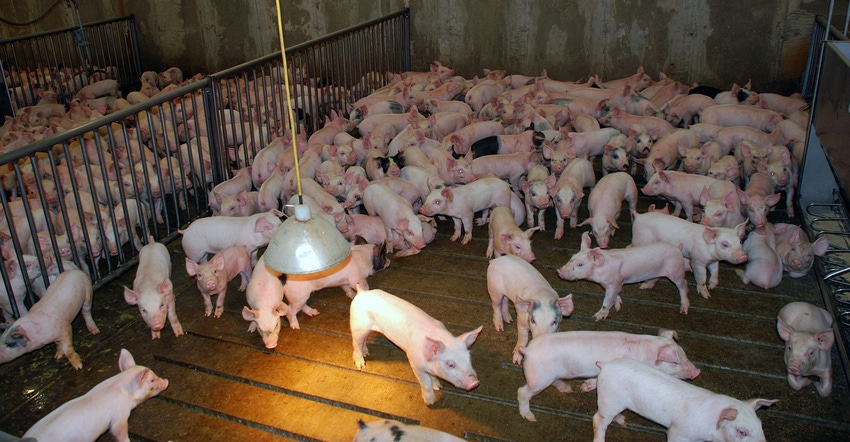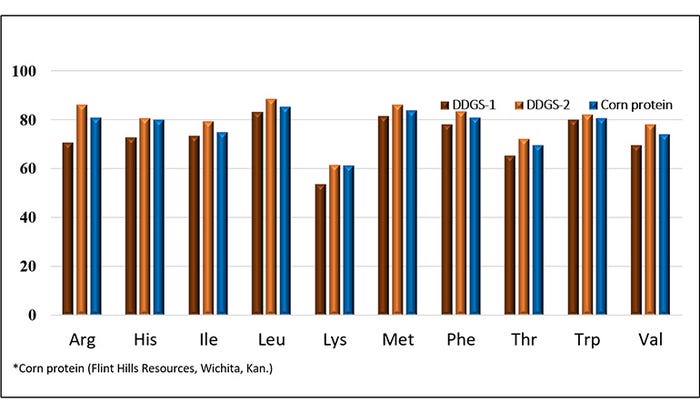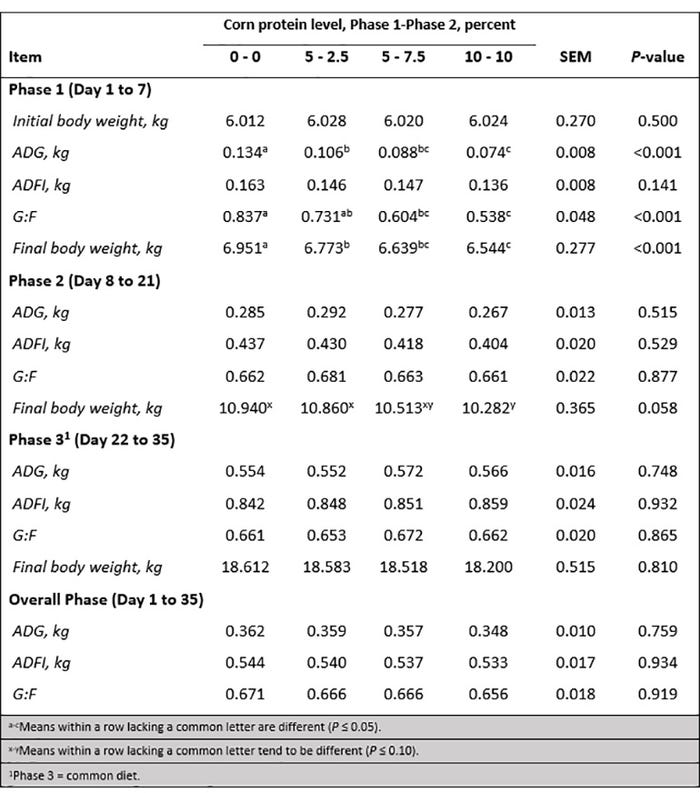Offers greater digestibility of amino acids and energy than low-oil distillers dried grains with solubles when fed to pigs.
October 29, 2020

Distillers dried grains with solubles is a co-product from the ethanol industry that can be included in diets to support growth performance of pigs. However, the industry has begun to further fractionate the whole stillage by separating some of the non-protein components, resulting in a protein-rich DDG containing over 50% crude protein (Flint Hills Resources, Wichita, Kan.).
This corn protein source, created by mechanically separating the corn fractions, may be included in diets for pigs as an alternative to animal and plant proteins. However, there has been limited data to demonstrate the nutritional value of corn protein produced using this technology.
Therefore, two experiments were conducted to test the hypothesis that the standardized ileal digestibility of amino acids and concentration of metabolizable energy in corn protein are greater than in two sources of DDGS (i.e., DDGS-1 and DDGS-2) when fed to pigs. An additional experiment was conducted to test the hypothesis that corn protein may be included in diets for nursery pigs without reducing growth performance.
Nutrient digestibility results
Greater SID of amino acids was observed in corn protein and DDGS-2 than in DDGS-1 (Figure 1). The SID of isoleucine, leucine, methionine and valine was greater in DDGS-2 compared with DDGS-1 and corn protein. However, due to increased concentration of amino acids in corn protein, the concentration of all standardized ileal digestible amino acids was greater in corn protein than in the two sources of DDGS.

The apparent total tract digestibility of gross energy in corn protein was also greater compared with DDGS-1 and DDGS-2. The concentration of metabolizable energy (as-fed basis) in corn protein was 3,504 kilocalories per kilogram, and this value was greater than in DDGS-1 (2,813 kilocalories per kilogram) and DDGS-2 (2,581 kilocalories per kilogram).
Growth performance
Results from the two digestibility experiments indicate that corn protein is a valuable source of energy and digestible amino acids in diets fed to pigs. Therefore, an experiment was conducted to test the hypothesis that plasma protein and enzyme-treated soybean meal can be replaced by corn protein in diets without compromising growth performance of pigs. A three-phase feeding program was used with Day 1 to Day 7 as Phase 1; Day 8 to Day 21 as Phase 2; and Day 22 to Day 35 as Phase 3.
Pigs were fed one of four diets during Phases 1 and 2, but a common diet in Phase 3. The control diet in Phase 1 contained 5% enzyme-treated soybean meal and 2.5% plasma protein and no corn protein. Two additional diets were formulated by replacing either plasma protein or enzyme-treated soybean meal by 5% corn protein, and an additional diet was formulated by replacing both plasma protein and enzyme-treated soybean meal by 10% corn protein.
In Phase 2, the control diet contained 7.5% enzyme-treated soybean meal and no plasma or corn protein. Three additional diets were formulated to contain 2.5, 7.5 or 10% corn protein at the expense of enzyme-treated soybean meal. All Phase 1 diets contained 5% DDGS, whereas all Phase 2 diets contained 7.5% DDGS. The common Phase 3 diet was based on corn, soybean meal and 10% DDGS.
In Phase 1, average daily gain and final body weight of pigs fed the control diet were greater compared with pigs fed the other three diets (Table 1). At the end of Phase 2, there was no difference in final body weight when pigs were fed 2.5% or 7.5% corn protein compared with the control diet.

However, a tendency for reduction in final body weight was observed at the 10% inclusion. No differences were observed for average daily gain, average daily feed intake and gain-to-feed ratio in Phase 2. Likewise, average daily gain, average daily feed intake, gain-to-feed ratio and final body weight at the end of Phase 3 and for the overall experimental period were not different among treatments.
It was, therefore concluded that corn protein may be included in Phase 1 and Phase 2 diets for weanling pigs by at least 5 and 7.5%, respectively.
Overall conclusions
Concentrations of standardized ileal digestible amino acids and metabolizable energy in corn protein were greater than in two sources of DDGS used in the present studies. Pigs fed diets containing corn protein had reduced average daily gain and final body weight during Phase 1, but inclusion of corn protein in diets did not affect the overall growth performance of pigs.
Footnote: Flint Hills Resources, Wichita, Kan., is dedicated to continuous research to further the industry knowledge of corn kernel separation processes in determining nutrient availability to optimize performance from nursery to the finished animal.
Sources: Charmaine D. Espinosa, Jessica P. Acosta and Hans H. Stein, who are solely responsible for the information provided, and wholly own the information. Informa Business Media and all its subsidiaries are not responsible for any of the content contained in this information asset.
You May Also Like


